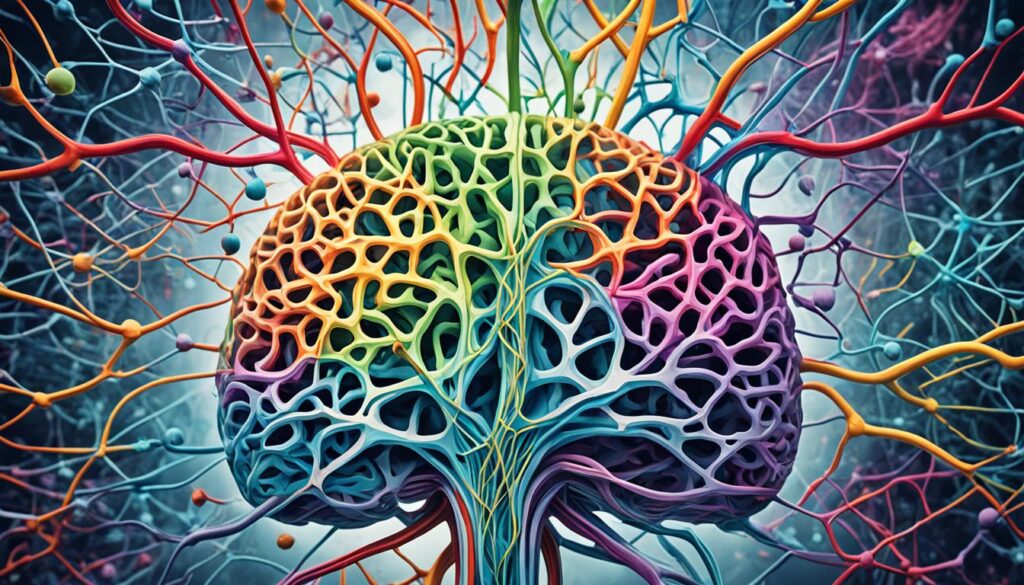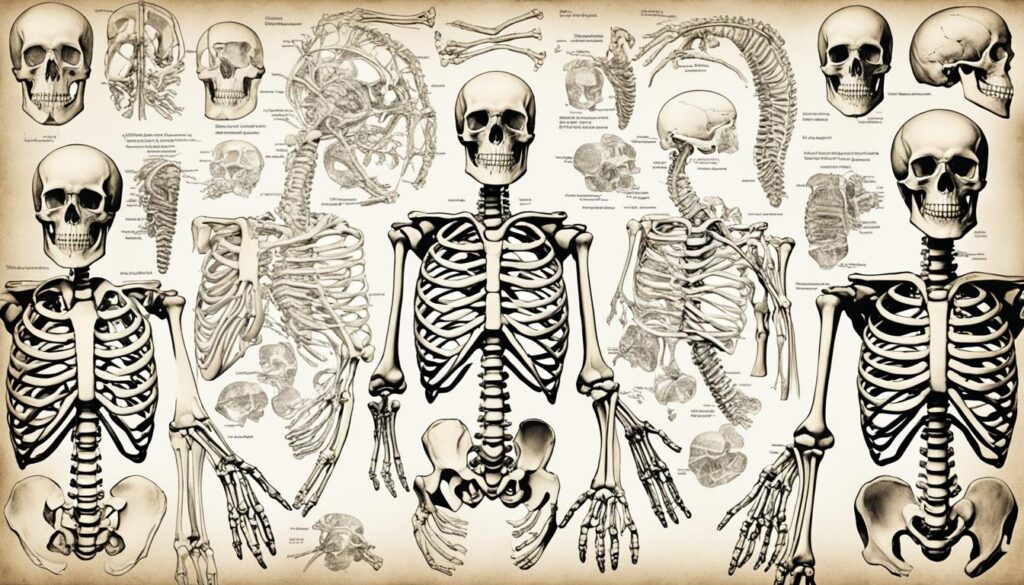The human body is a complex and amazing machine. It’s a wonder of nature that fascinates scientists, doctors, and everyone else. It has trillions of cells working together and complex systems that keep us alive. This guide will share interesting facts about the human body. We’ll look into the anatomy and physiology that define us.
Let’s discover the amazing facts that highlight the power and resilience of the human body. This article is perfect for students, medical fans, or anyone curious about the human body. It will show you the incredible science inside each of us.
The Incredible Complexity of the Human Body
The human body is a masterpiece of engineering, made up of trillions of cells working together. These cells form specialized systems with key functions. For example, the circulatory system carries nutrients and oxygen, while the nervous system controls the body’s actions.
Trillions of Cells Working in Unison
Our bodies have about 37.2 trillion cells, each with a unique job to keep us healthy. They’re grouped into systems like the muscular, digestive, and immune systems. Together, they make sure our bodies work perfectly.
Intricate Systems and Functions
The human body is amazing in its complexity. Each system is crucial for our health. The cardiovascular system sends blood around the body, and the respiratory system helps us breathe in oxygen.
Learning about the complexity of the human body helps us stay healthy. By understanding the systems and functions inside us, we see the incredible engineering that makes us who we are.
Educational: Fascinating Facts About the Brain
The human brain is a marvel of evolution. It lets us think, learn, and see the world. This amazing organ is full of interesting facts that show how it works and its key role in our lives.
Did you know the brain has about 86 billion neurons? Each one can connect with thousands of others. This network lets the brain process information fast, helping us do complex tasks easily. Research shows the brain can change and make new paths as we age, a process called neuroplasticity.

The brain is also very efficient with energy. It makes up just 2% of our weight but uses 20% of our energy. This lets it work at its best, controlling our thoughts, feelings, and actions with great detail.
Looking into how the brain works helps us understand learning and thinking better. Scientists have found different parts of the brain handle different tasks, like language, memory, and solving problems. Knowing this can help us make better learning plans.
As we learn more about the brain, we’re always amazed by its complexity and what it can do. By exploring the brain’s fascinating facts, we can appreciate how amazing our minds are and what they can achieve.
The Powerful Pumping Machine: The Heart
At the heart of our body is a muscle that never stops working. This amazing organ pumps blood through our body’s vessels all day and night. The human heart is a powerful machine, showing incredible endurance.
Cardiac Capabilities and Endurance
The heart is a true marvel, beating about 100,000 times daily. It pumps around 2,000 gallons of blood. This vital organ keeps a steady beat, even when we’re active or stressed. Its endurance shows how crucial it is for our body’s health.
It’s amazing how the heart works. In just 60 seconds, it sends blood to every part of the body and back. This happens without stopping for our whole lives. The heart’s muscle tissue makes this possible, working in a special rhythm to move blood.
The heart shows how complex and strong our bodies are. It’s key to our health and well-being. By understanding how it works, we see its vital role in keeping us alive.
The Skeletal System: Our Sturdy Foundation
The human skeletal system is an amazing piece of engineering. It forms the base of our bodies. It includes bones, joints, and connective tissues. These parts support our weight, protect vital organs, help us move, and make blood cells.
Our skeletal system has 206 bones, each with its own job. From the long bones in our legs to the small bones in our hands and feet, they vary in shape and size. This variety is key for supporting our body, allowing movement, and protecting our organs.

Our bones are incredibly strong and resilient. They are made of a mix of collagen fibers and minerals like calcium and phosphorus. This mix lets our bones handle big forces and stresses. It helps us move and be active without getting hurt.
But the skeletal system does more than just support us. It’s where our body makes blood cells. This process happens in the bone marrow, the spongy part inside our bones. There, stem cells turn into different blood cells we need to stay healthy.
In summary, the human skeletal system is a wonder of engineering. It gives us the base we need to move, grow, and live well. Learning about its complexity and importance helps us appreciate how amazing our bodies are.
Digestive Wonders: Breaking Down Complex Foods
The human digestive system is amazing, turning complex foods into the nutrients our bodies need. This starts when we take a bite, setting off a chain reaction. Food moves through the digestive tract, getting broken down step by step.
The Journey from Mouth to Intestines
When food goes into the mouth, the digestive journey starts. Enzymes in saliva start breaking down carbs, and our teeth and tongue make the food smaller. Then, it goes down the esophagus and into the stomach.
In the stomach, strong acids and enzymes keep breaking down the food. This mixture, called chyme, moves into the small intestine next. Here, the body absorbs important nutrients like proteins, fats, and carbs. This happens thanks to tiny projections called villi on the intestinal walls.
By the time food reaches the large intestine, most nutrients are gone. The large intestine focuses on absorbing water and electrolytes. This makes the waste solid, ready to be eliminated from the body.
The human digestive system is truly amazing. It turns food into the building blocks our bodies need. From the first bite to the last step, this process shows how complex and adaptable our bodies are.
The Respiratory System: Breathing Life
The human respiratory system is a wonder of engineering. It’s key for the vital process of breathing. This system brings oxygen to the body’s cells and takes out carbon dioxide. This keeps us alive.
Let’s look at how the respiratory system works. We’ll see how it exchanges oxygen and how much air the lungs can hold.
Oxygen Exchange and Lung Capacity
The lungs are at the center of the respiratory system. They are where oxygen and carbon dioxide are swapped. When we breathe in, oxygen-rich air goes into the lungs.
It then spreads to tiny air sacs called alveoli. These sacs have walls that let oxygen get into the bloodstream. From there, oxygen goes to the body’s cells.
The lungs can hold a lot of air. A healthy adult can hold up to 6 liters of air. During hard activity, they can move up to 15 liters of air a minute. This means the body gets enough oxygen to work right.
The diaphragm, a muscle that moves air in and out, helps the lungs work better. It contracts and relaxes to make breathing easy, even when we’re active.
The human respiratory system shows how amazing our bodies are. It’s key for exchanging gases that keep us alive. By understanding it, we see how complex and strong our bodies are.
Immunity Warriors: Defending the Body
The human immune system is amazing, a complex network of cells and organs protecting us from harm. At its core are white blood cells, or leukocytes, the immunity warriors. They keep an eye out for threats all the time.
White blood cells like lymphocytes, macrophages, and neutrophils team up to fight off invaders. They make proteins called antibodies that tag and destroy harmful germs. This keeps our bodies healthy and strong.
The immune system is incredible at spotting and fighting threats. When it finds a pathogen, white blood cells rush to the infection site. They use signals and different immune cells to attack the invader together.
The immune system does more than just fight infections. It helps heal and repair our bodies by removing damaged cells and fixing injured tissues. It’s always changing and getting better, ready for any threat that comes our way.
Learning about the human immune system shows us how vital these warriors are for our health. By supporting our immune system, we help our bodies stay strong and ready for whatever life brings.
Sensory Marvels: Sight, Sound, and Beyond
The human body is amazing, filled with sensory organs that let us see and hear the world. Our vision and hearing are incredible, showing nature’s wonders.
The Wonders of Vision and Hearing
Our eyes let us see the world in all its beauty. They work with the brain to catch light, color, and movement. This lets us see faces, move around safely, and enjoy the beauty of nature.
Our ears make hearing possible, from soft whispers to loud music. They turn sound waves into signals the brain understands. This helps us feel emotions, connect with others, and understand our world.
But there’s more to our senses than just seeing and hearing. We have touch receptors in our skin and taste buds on our tongue. These help us feel and taste the world, making our experiences richer.
Our senses let us explore, learn, and connect with the world deeply. They show how complex and adaptable the human body is.
Regeneration and Healing: The Body’s Resilience
The human body is amazing in what it can do. It can heal from many injuries and illnesses. This shows how strong it is.
At the cell level, stem cells help the body heal and regenerate. They turn into different cells to fix damaged tissues. This is key for the body to recover from injuries and daily wear and tear.
The body’s healing is impressive, with the immune system fighting infections. It also has natural ways to repair tissues. Things like blood clotting and growth factors show how adaptable and complex the human body is.






